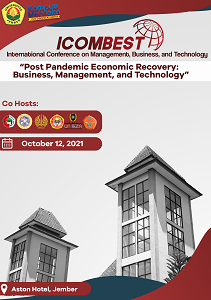EFFECT OF COMBINATION SODIUM ALGINATE-GELATIN 1% : 2% CONTENT IN CHARACTERISTIC AND ANTIMICROBIAL ACTIVITY OF PROBIOTIC MICROSPHERES Lactobacillus acidophilus
Abstract
Probiotics is live micro-organisms which whenadministered in adequate amounts, confer a
health benefit on the host (FAO / WHO, 2002).
Probiotics may give therapeutic effect in minimal
amounts 106-107cfu/g daily. Some reports in the
last decade have described that probiotic, such as
Lactobacillus acidophilus, is useful for treating skin
disorder such as dermatitis, acne, cellulitis, and
psoriasis. This relates to the content of probiotics
metabolites that protect the skin from most
pathogenic bacteria, such as Staphylococcus
aureus, and improve skin structure (Cinque et al.,
2011).
In topical application, the active ingredient should
last a long time on the skin and prolonged release.
Meanwhile, Lactobacillus acidophilus unstable to
environtment factors, such as the high
temperature, oxygen, and humidity (Al-Hurr,
2011). Therefore, probiotics encapsulation is
needed. In addition, encapsulation also may
provide prolonged release so that its effectiveness
increased as antimicrobial activity becomes longer.
Encapsulation process that forms microparticles (1-
1000 μm) called micro-encapsulation. Spherical
microparticles called microspheres (Sahil et al.,
2011). The recommended size of microspheres
which active ingredient site action is in epidermis
layer is 5-300 μm (Chadawar and Shaji, 2007).
Sodium alginate is widely used as a matrix of
microencapsulated probiotics. Microspheres made
with sodium alginate matrix may improve the
viability of probiotics during storage. Gelatin also
often used in microencapsulated probiotics
(Solanki et al., 2013). Gelatin is biodegradable,
non-toxic, and easy to experience a cross-linking so
that it can be used in the preparation of colloidal
delivery systems, such as microspheres and
nanoparticles (Sailaja, et al., 2010).
Type of matrix influence the characteristic of
microsphere. Microspheres are only made with
sodium alginate tend to provide simultaneous
release. Therefore for prolonged release, sodium
alginate should be combined with gelatin (Lee et
al., 2014; Roy et al., 2009). Combination of sodium
alginate and gelatine in the ratio 1: 2 will provide
small particle size that not easily aggregate during
the process of mixing and drying (Lee et al., 2014).
In this study, microspheres were formed by cross
linking between combination of sodium alginate
and gelatin (1% : 2%) with CaCl2 as cross linker
using ionotropic gelation method.
OBJECTIVE
The aim of this research was to investigaste the
effect of combination of sodium alginate and
gelatin (1% : 2%) content in characteristics and
antimicrobial activity of probiotic microspheres
Lactobacillus acidophilus.
Published
2017-01-27
How to Cite
ASSHAFA, Regia Nada; PURWANTI, Tutiek; HARIYADI, Dewi Melani.
EFFECT OF COMBINATION SODIUM ALGINATE-GELATIN 1% : 2% CONTENT IN CHARACTERISTIC AND ANTIMICROBIAL ACTIVITY OF PROBIOTIC MICROSPHERES Lactobacillus acidophilus.
UNEJ e-Proceeding, [S.l.], p. 10-13, jan. 2017.
Available at: <https://jurnal.unej.ac.id/index.php/prosiding/article/view/3875>. Date accessed: 22 dec. 2024.
Section
General









